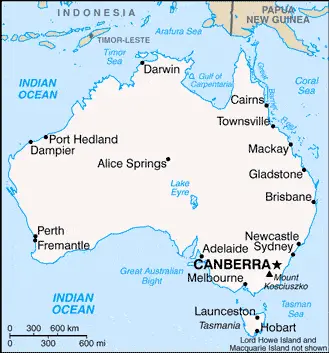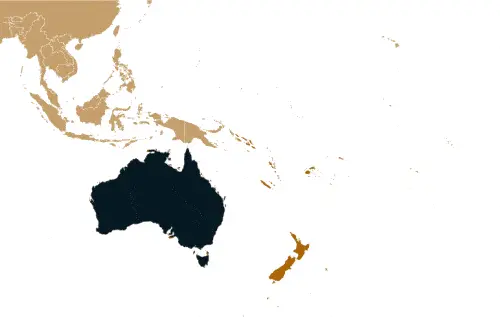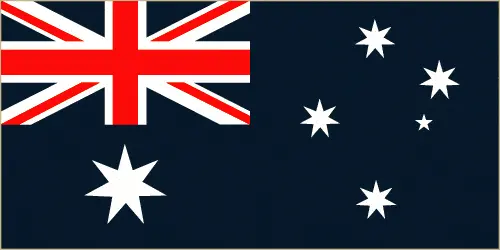Google Maps and Detailed Facts of Australia (AU). This page lets you explore Australia and its border countries (Country Location: Oceania, continent between the Indian Ocean and the South Pacific Ocean) through detailed Satellite imagery – fast and easy as never before Google Maps.
Find comprehensive information about this country’s diversity below: Google Maps, geography, economy, science, people, culture, environment, government, and history – All in One Wiki page.
There is also a Street View and free Driving Directions at your service. Your Google Satellite Map Sightseeing in Australia, in Oceania, starts here at Driving Directions and Maps.com.
About Australia in detail
Table of contents
- Background
- Overview
- Google Maps
- Climate
- Geography
- Resources and Land Use
- Population Data
- Economic Data
- Drinking Water Source
- Population, Median Age, Migration, and Citizenship
- Average Number of Childbirths
- Is this country a Safe Destination?
- Healthcare and Infectious Diseases
- Natural Hazards
- The Flag and Other Symbols
- Constitution
- Legal System
- About the Unemployment Rate, Labor Force, and Poverty Line
- About the Budget and Central Government Debt
- Inflation Rate and Prime Lending Rate
- Export/Import Partners and Data
- Renewable Energies Used
- Telecommunication Data, Calling Code
- Transport Infrastructure
- More Interesting Facts
Background
Australia’s history is rich and complex, beginning with the Aboriginal Australians who arrived at least 60,000 years ago. They developed sophisticated hunter-gatherer societies and rich oral traditions. The first European contact was by Dutch navigators in 1606, followed by English Captain James Cook’s arrival in 1770, claiming the land for Great Britain. Establishing penal colonies, extensive gold rushes, and the eventual federation of the colonies in 1901 mark key moments in Australia’s path to becoming a Commonwealth nation. Its significant contributions during both World Wars, the gradual severing of constitutional ties with the UK, and its evolving political landscape, particularly in the early 2000s, reflect its dynamic history and development.
Overview
Australia, known for its diverse landscape, vibrant culture, and strong economy, is a significant player on the global stage. Its advanced market economy owes much to reforms in the 1980s and its proximity to East and Southeast Asia. The nation’s commitment to environmental sustainability, evident in its handling of natural resources and conservation efforts, particularly in the Great Barrier Reef, is noteworthy. While experiencing instability in the early 2000s, Australia’s political scene has stabilized, contributing to its reputation as a stable and prosperous nation.
Official Name: Commonwealth of Australia
Date of Formation: 1 January 1901 (from the federation of UK colonies)
Capital: Canberra
Population: 26,461,166 (2023 est.)
Total Area: 7,741,220 sq km
Population Density: N/A
Languages: English 72%, Mandarin 2.7%, Arabic 1.4%, Vietnamese 1.3%, Cantonese 1.2%, other 15.7%, unspecified 5.7% (2021 est.)
Religions: Roman Catholic 20%, Protestant 18.1% (Anglican 9.8%, Uniting Church 2.6%, Presbyterian and Reformed 1.6%, Baptist 1.4%, Pentecostal 1%, other Protestant 1.7%), other Christian 3.5%, Muslim 3.2%, Hindu 2.7%, Buddhist 2.4%, Orthodox 2.3% (Eastern Orthodox 2.1%, Oriental Orthodox 0.2%), other 2.7%
Ethnic Origin: English 33%, Australian 29.9%, Irish 9.5%, Scottish 8.6%, Chinese 5.5%, Italian 4.4%, German 4%, Indian 3.1%, Australian Aboriginal 2.9%, Greek 1.7%, unspecified 4.7%
Government: Federal parliamentary democracy under a constitutional monarchy; a Commonwealth realm
Currency: Australian dollars (AUD)
Literacy Rate Rate: N/A
Calorie Consumption: N/A
Australia Google Maps
Google Maps is essential for exploring Australia’s vast and varied landscape. From the bustling cities of Sydney and Melbourne to the remote outback and the stunning Great Barrier Reef, Google Maps provides comprehensive and user-friendly navigation, making it invaluable for both residents and tourists.
An island continent in its own right, Australia is the world’s sixth-largest country. European settlement began over 200 years ago. Most Australians now live in cities along the coast. Located between the Indian and Pacific oceans, Australia has a variety of landscapes, including tropical rainforests, the arid plateaus, ridges, and vast deserts of the “red center,” the lowlands and river systems draining into Lake Eyre, rolling tracts of pastoral land, and magnificent beaches around much of the coastline. In the far east are the mountains of the Great Dividing Range. Famous natural features include Uluru (Ayers Rock) and the Great Barrier Reef.
The map below shows Australia’s cities, towns, highways, main roads, streets, and Street Views. To find a location, use the form below, type any city or place, view a simple map, and click the “show map” button.
The Google Maps above shows Australia with its location: Oceania (geographic coordinates: 27 00 S, 133 00 E) and the international borders of Australia; 0 km; furthermore, its inland counties boundaries.
The map of Australia and Oceania is for informational use only. No representation is made or warranted given any map or content by the Driving Directions and Maps site. The user assumes all risks of using this Australia Google Maps and facts/wiki.
Climate
Australia, known for its vast and diverse landscapes, experiences a wide range of climatic conditions that significantly influence its varied ecosystems:
- Arid and Semiarid Climate: Much of central and western Australia falls into the arid and semiarid climatic zones. These areas, including the famous Outback, receive less than 500 mm (19.7 inches) of rain annually and, in some parts, less than 250 mm (9.8 inches). These regions’ temperatures can be extreme, with summer temperatures often soaring above 40°C (104°F).
- Temperate Climate in the South and East: The southern and eastern parts of Australia, including regions like New South Wales, Victoria, and Tasmania, experience a temperate climate. This region has more distinct seasons than Australia’s, with cool, wet winters and warm, dry summers. Average temperatures in the summer range from 20°C to 30°C (68°F to 86°F), while winter temperatures can drop below 10°C (50°F).
- Tropical Climate in the North: Northern Australia, including Queensland, parts of the Northern Territory, and Western Australia, experiences a tropical climate. This region is characterized by hot and humid conditions year-round. It is divided into a ‘wet’ season (November to April) with heavy rains and a ‘dry’ season (May to October). Average temperatures typically range from 25°C to 35°C (77°F to 95°F).
- Impact on Ecosystems: Australia’s climatic diversity supports a range of ecosystems. The arid zones are home to vast deserts and scrublands, while the temperate regions support lush forests, fertile plains, and important agricultural areas. Rainforests and wetlands thrive in the tropical north, including the UNESCO World Heritage-listed Great Barrier Reef.
- Marine Environments: Australia’s climate also influences its extensive marine environments. The warmer northern waters support vibrant coral reefs, while the cooler southern waters are home to unique marine species such as the Leafy Sea Dragon.
- Biodiversity Hotspots: Regions like the southwest of Western Australia and parts of Queensland are recognized as biodiversity hotspots due to their unique flora and fauna, much of which are adapted to specific climatic conditions.
- Climate Change Impact: Australia is particularly vulnerable to the effects of climate change, with increasing temperatures, changing precipitation patterns, and more frequent extreme weather events like bushfires, droughts, and cyclones.
- Microclimates: Within these broad climatic zones, there are numerous microclimates. For instance, the Snowy Mountains in New South Wales experience snowfall in winter, while Tasmania’s west coast is known for its high rainfall.
Australia’s diverse climate not only shapes its natural beauty and ecosystems but also presents challenges and opportunities for agriculture, tourism, and conservation. From the arid outback to the lush rainforests and vibrant coral reefs, the climatic variations play a pivotal role in sustaining the country’s unique biodiversity.
Geography
Australia’s geographical features and location play a crucial role in shaping its diverse landscapes, ecosystems, and environmental significance:
- Size and Global Position: As the world’s smallest continent and sixth-largest country, Australia spans an area of approximately 7.692 million square kilometers (2.97 million square miles). It is situated between the Indian Ocean to the west and the South Pacific Ocean to the east.
- Predominant Landscapes: Much of Australia’s interior is characterized by low plateaus and deserts, known as the Outback. This vast area includes famous deserts like the Great Victoria, Simpson, and Tanami Deserts. These regions are known for their sparse population, extreme temperatures, and unique desert ecosystems.
- Fertile Plains in the Southeast: In contrast to the arid interior, the southeast regions of Australia, particularly along the eastern coast and in Tasmania, boast fertile plains. This area supports a significant portion of the country’s agricultural production, with a climate more conducive to diverse agricultural activities.
- Coastal Features: Australia has a long coastline extending approximately 59,736 kilometers (37,119 miles), featuring a mix of beautiful beaches, cliffs, and bays. The Great Barrier Reef, the world’s largest coral reef system, lies off the northeast coast and is a major marine biodiversity hotspot.
- Unique Biodiversity: The continent is renowned for its unique flora and fauna. Many of its wildlife, including kangaroos, koalas, wombats, and most of its plant species, are endemic to Australia.
- Mountain Ranges: While generally flat, Australia does have mountain ranges, such as the Great Dividing Range along the east coast, which includes the Snowy Mountains. The highest point in Australia is Mount Kosciuszko, standing at 2,228 meters (7,310 feet) in the Snowy Mountains.
- Surrounding Countries and Territories:
- To the north, Australia is bordered by Indonesia, East Timor, and Papua New Guinea across the Arafura and Timor Seas.
- To the northeast, it is bordered by the Solomon Islands, Vanuatu, and the French territory of New Caledonia.
- To the southeast, New Zealand is its closest neighbor, separated by the Tasman Sea.
- Island Territories: Apart from the mainland, Australia also includes numerous islands, the largest being Tasmania to the south.
- Varied Climates and Ecosystems: Australia’s vast size means it encompasses a variety of climates, from tropical in the north to temperate in the south, influencing its diverse ecosystems, which range from rainforests and heathlands to mangroves and alpine areas.
Australia’s geography, with its vast deserts, fertile plains, unique biodiversity, and extensive coastline, not only makes it a land of contrasts but also significantly contributes to its cultural identity, economy, and environmental significance on a global scale.
Resources and Land Use
Rich in natural resources, Australia is a major exporter of commodities like coal, iron ore, and gold. Agricultural land accounts for 46.65% of the land use, with significant contributions from sectors such as wheat and beef production. Forests cover 17.42% of the land, contributing to the nation’s biodiversity and environmental management.
Population Data
As of 2023, Australia’s population is estimated at 26,461,166. The population is primarily located along the coast, with major urban centers in the east, southeast, and around Perth in the west. The vast interior, known as the “outback,” is sparsely populated.
Economic Data
Australia’s economy is internationally competitive, with a GDP of $1.279 trillion (2021 est.). Its post-war economic boom and subsequent reforms have made it an advanced market economy. The country’s proximity to Asia is significant in its economic dynamics.
Drinking Water Source
Australia boasts a 100% improved drinking water source for urban and rural populations, reflecting its public health and infrastructure commitment.
Population, Median Age, Migration, and Citizenship
The median age in Australia is 37.9 years as of 2023. The country experiences a healthy migration rate, contributing to its multicultural society. Citizenship laws are aligned with residency and descent, with allowances for dual citizenship.
Average Number of Childbirths
The average number of childbirths per woman in Australia is 1.73 (2023 est.), reflecting trends in developed nations towards smaller family sizes.
Is this country a Safe Destination?
Australia is considered a safe travel destination with standard safety advisories. Natural hazards like cyclones and forest fires are the primary safety concerns, particularly in certain regions.
Healthcare and Infectious Diseases
Australia offers high-quality healthcare services, with a current health expenditure of 10.7% of GDP (2020). The country’s healthcare system is well-equipped to handle various medical needs and emergencies.
Natural Hazards
Australia faces natural hazards such as cyclones along the coast, severe droughts, and forest fires. The country is also known for its unique challenges related to its diverse and rugged terrain.
The Flag and Other Symbols
Australia’s flag features the Union Jack, a large seven-pointed star, and a representation of the Southern Cross constellation. The kangaroo and emu are significant national symbols, representing the country’s unique wildlife and cultural heritage.
Constitution
Australia’s constitution, effective from 1901, outlines its federal parliamentary democracy under a constitutional monarchy. It has been amended several times, with the last amendment in 1977.
Legal System
Australia’s legal system is based on English common law. It includes a mix of statutes passed by the Parliament and common law (court rulings), ensuring a comprehensive legal framework.
About the Unemployment Rate, Labor Force, and Poverty Line
The unemployment rate in Australia was 5.11% in 2021. Its diverse labor force, with significant contributions from various sectors, reflects a healthy and dynamic economy.
About the Budget and Central Government Debt
Australia’s budget focuses on various sectors, including public services and infrastructure. The public debt was 69.41% of GDP in 2020, indicating sound fiscal management.
Inflation Rate and Prime Lending Rate
The inflation rate in Australia was 2.86% in 2021. The country maintains a stable economic environment, with fiscal policies that manage inflation effectively.
Export/Import Partners and Data
Major export partners include China, Japan, and South Korea, with key exports being iron ore, coal, and natural gas. Imports mainly consist of refined petroleum, cars, and broadcasting equipment.
Renewable Energies Used
Australia actively invests in renewable energy, focusing on solar and wind power. The transition to renewable energy sources is a key aspect of its commitment to environmental sustainability.
Telecommunication Data, Calling Code
Australia has a well-developed telecommunications infrastructure focusing on mobile and broadband services. The international calling code for Australia is +61.
Transport Infrastructure
Australia’s transport infrastructure is extensive, including a well-developed network of roads, railways, and air transport facilities. It is crucial in connecting its vast territory and supporting economic activities.
More Interesting Facts
Australia is known for its unique wildlife, including kangaroo and koala species. The country is also famous for its cultural landmarks like the Sydney Opera House and natural wonders like the Great Barrier Reef. Australia’s diverse and multicultural society, natural beauty, and strong economy make it a fascinating and dynamic nation.
Did You Know?
- Oldest Living Civilization: Australia is home to the world’s oldest continuous living culture. The Indigenous Aboriginal Australians have a history of over 65,000 years, rich in cultural heritage, art, and connection to the land.
- Megadiverse Country: Australia is one of only 17 countries considered megadiverse. It’s home to a vast array of unique wildlife, including over 80% of mammals, 70% of birds, and 95% of amphibians that are found nowhere else on Earth.
- Great Barrier Reef: The Great Barrier Reef, off the coast of Queensland, is the world’s largest coral reef system and the only living organism visible from space. It spans over 2,300 kilometers and includes thousands of individual reefs and hundreds of islands.
- Largest Sand Island: Fraser Island in Queensland is the world’s largest sand island, known for its unique dune landscapes, rainforests, and diverse wildlife.
- Extreme Weather Records: Australia holds the record for the world’s longest heatwave. In the summer of 1923-24, Marble Bar in Western Australia experienced 160 consecutive days of temperatures above 37.8°C (100°F).
- Pink Lakes: Australia has several naturally pink lakes, including Lake Hillier in Western Australia. The unique color is due to algae and high salt concentration.
- Opal Capital: Australia produces over 90% of the world’s opals. Coober Pedy in South Australia is known as the Opal Capital of the World and is famous for its underground residences, built to escape the extreme heat.
- Largest Fence: The Dingo Fence in Australia is the world’s longest fence, stretching 5,614 kilometers (3,488 miles). It was originally built to keep dingoes away from fertile land.
- Varied Climates: Australia’s size means it experiences varied climates, from tropical in the north to desert in the center and temperate in the south. It even sees snow in the high country of the southeastern states.
- Unique Flora: Australia is known for its unique plant life, including the eucalyptus tree and various Acacia (wattle) species, the national floral emblem.
These facts showcase Australia’s extraordinary diversity, from its ancient cultures and unique wildlife to its natural wonders and quirky records, making it a land of endless fascination and discovery.
Many thanks for visiting and sharing this map & country information site!



